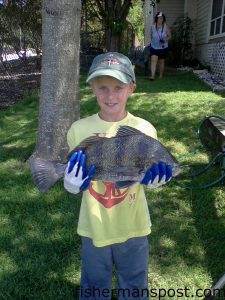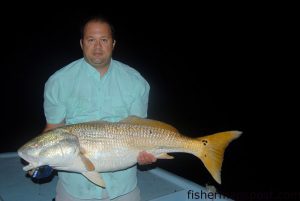Pamlico August 22, 2013
Gary, of Spec Fever Guide Service, reports that anglers are hooking good numbers of large red drum in the lower Neuse River, and casting artificials has been more productive with the big reds than soaking bait lately.
Searching for signs of menhaden, bluefish, and surface slicks in less than 10’ of water has produced the best results. When anglers find good water, casting D.O.A. soft plastics under popping corks and, at times, flies has been fooling the large drum.
Some puppy drum and trout are feeding along the shorelines in the lower Neuse, but wind and rain have made them a bit tough to target recently. On breezy days, soaking cut mullet on downsized Owen Lupton rigs should produce some puppy drum. Soft plastic baits are producing results when the weather’s better.
Striped bass are still feeding around the stump fields, bridge pilings, and other structure near New Bern, but the water temperature has fallen several degrees and made the bite a bit inconsistent. Casting topwater plugs around shoreline structure in the early morning hours should still produce some action.
Dave, of Knee Deep Custom Charters, reports that anglers are connecting with citation-class “old” red drum in a variety of areas in the lower Neuse River right now. They’re feeding near shorelines and on shallow shoals, where anglers are casting D.O.A. Airhead soft plastics under popping corks to fool the big fish.
Anglers can also soak cut baits around the edges of shoals and ledges to connect with the big reds.
Speckled trout, puppy drum, and flounder are providing light-tackle action for anglers working the shorelines of the lower river. Most have been falling for live baits and D.O.A. shrimp lately.

Ryder Pressly, of Kinston, NC, with a black drum he hooked while fishing the lower Neuse River out of Orieintal with Capt. Dave Stewart of Knee Deep Custom Charters.
Black drum are also feeding around shoreline structure, where they’ll fall for shrimp or crabs fished on the bottom.
Mitch, of FishIBX.com, reports that anglers are finding catch and release action with trophy red drum throughout the western Pamlico sound and lower Neuse, Pamlico, and Pungo rivers. They can be caught in a variety of ways, including still-fishing or drifting with live and cut baits around shoals and other areas where they’ve recently been active. Casting topwater plugs and large soft plastics around signs of feeding fish will also produce hookups with the big reds. However anglers connect with them, a quick battle and release is important to keep the spawning fish in the best shape possible.
For anglers looking to take some fish home, there are still plenty of flounder and puppy drum, along with a few speckled trout, feeding along the shorelines of the lower rivers and biting soft plastic baits.
Some croaker, spadefish, and other species are taking an interest in bottom rigs baited with shrimp.
Richard, of Tar-Pam Guide Service, reports that anglers are hooking some citation-class red drum on large Z-Man soft plastic baits worked under popping corks. Searching for signs of feeding fish and then covering the area with the float rigs is the way to hook up, and anglers who approach stealthily with the trolling motor greatly increase their odds of success.
Anglers are also hooking some of the giant reds while soaking cut baits around the edges of shoals and other bottom irregularities.
Isaiah, of East Side Bait and Tackle, reports that the big drum bite has gotten solid in the lower Pamlico River, and most anglers are hooking the fish on large cut baits, especially in the evening hours.
Striped bass are feeding around the bridges and other structure near Washington, and anglers have had good results with the stripers while casting topwater plugs recently.

